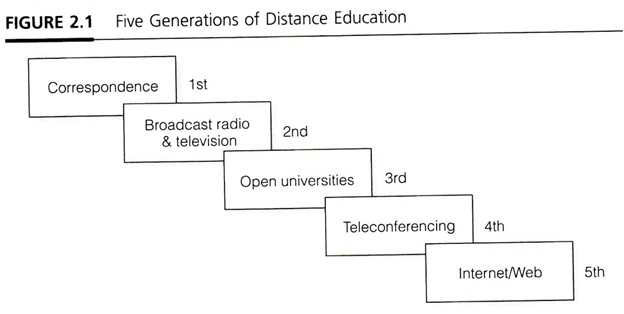(Moore, & Kearsley, 2012)
A little known movie fact is that the original Wizard of Oz had a jitterbug scene in it. The powers that be cut the scene because they didn’t want to date the movie. Years later, movie goers should be grateful that they get to experience the timeless wonder of Judy Garland’s performance of Over the Rainbow without any reminders of dances long out of date.
Moore & Kearsley’s (2012) definition of the five generations of distance education (DE) include Open Universities (OUs) as its own generation. This appears out of place as the other four generations are solidly about the technologies that provided mechanisms of education. A case could be made that Open Universities were enabled by the technologies of broadcast radio and television as home study was enabled by the technologies of cheaply created and easily distributed correspondence.
Let’s discuss two generations using technology, mechanism, pedagogy followed with examples. The first generation of Correspondence used printed instructions sent via the postal system to provide distance education following mainly objectivist theory (Jonassen, Davidson, Collins, Campbell, & Bannan Haag, 1995; Moore & Kearsley, 2012). Examples from the correspondence generation include correspondence study, home study and independent study courses (Moore & Kearsley, 2012). The second generation of Broadcast Radio and Television used audio and audiovisual programming sent via radio waves and/or TV frequencies to provide distance education following mainly constructivist theory (Jonassen, Davidson, Collins, Campbell, & Bannan Haag, 1995; Moore & Kearsley, 2012). Examples from the Broadcast Radio and Television generation include Schools of the Air, Corporation of Public Broadcasting, Instructional Television Fixed Services, Cable Television Telecourses, and Open Universities.
There is possibility that Moore & Kearsley’s (2012) definition of the five generations of distance education may become as outdated as the jitterbug by setting OUs apart in their own generation. While today OUs are flourishing mega-universities who knows what tomorrow may bring? In an era of downsizing, mergers, economic instability, doing everything, including providing education, for less money will continue to be a priority for governments around the world. Many OUs are funded by their governments. If funding is cut, it could spell difficult times ahead OUs – perhaps some OUs will have to close their doors.
By no means am I trying to trivialize the impact the OUs have made on DE. I feel that setting OUs apart as a separate generation as Moore and Kearsley have done may not be the most appropriate and long term decision when describing the history of DE.
REFERENCES
Jonassen, D., Davidson, M., Collins, M., Campbell, J., & Bannan Haag, B. (1995). Constructivism and computer-mediated communication in distance education. The American Journal of Distance Education, 9(2), 7-26. Available from http://www.box.com/s/i9y1f17cii6zmb0pi4qd
Moore, M.G., & Kearsley, G. (2012). The historical context. In Distance education: A systems view of online learning (3rd ed., pp. 23-44). Belmont, CA: Wadsworth CengageLearning.

Hi Joanne~
This is an interesting discussion; I had not considered whether OUs should be considered their own ‘generation’ in the history of DE. At first glance, I was inclined to agree with you. However, on further reflection, now I am not so sure.
Here in the USA we don’t have the large open universities that thrive in other countries, so perhaps we don’t really have a good concept about their impact. In countries such as China or Japan, OUs have paved the way for educating the masses, especially those outside the big city limits. Without OUs, how long would these students have had to wait for an education? Similarly, the OU in the UK broke down the barriers of exclusive education that alluded so many potential students.
It would appear that the time was right for OUs to appear on the scene. Without them and their outreach to so many new students, would the next generation in DE history have had a large of an impact?
Brenda
Brenda,
Great point about the OUs paving the educational path for so many people. That could have been one of the motivations behind Moore & Kearley’s choice.
Kind Regards, Joanne